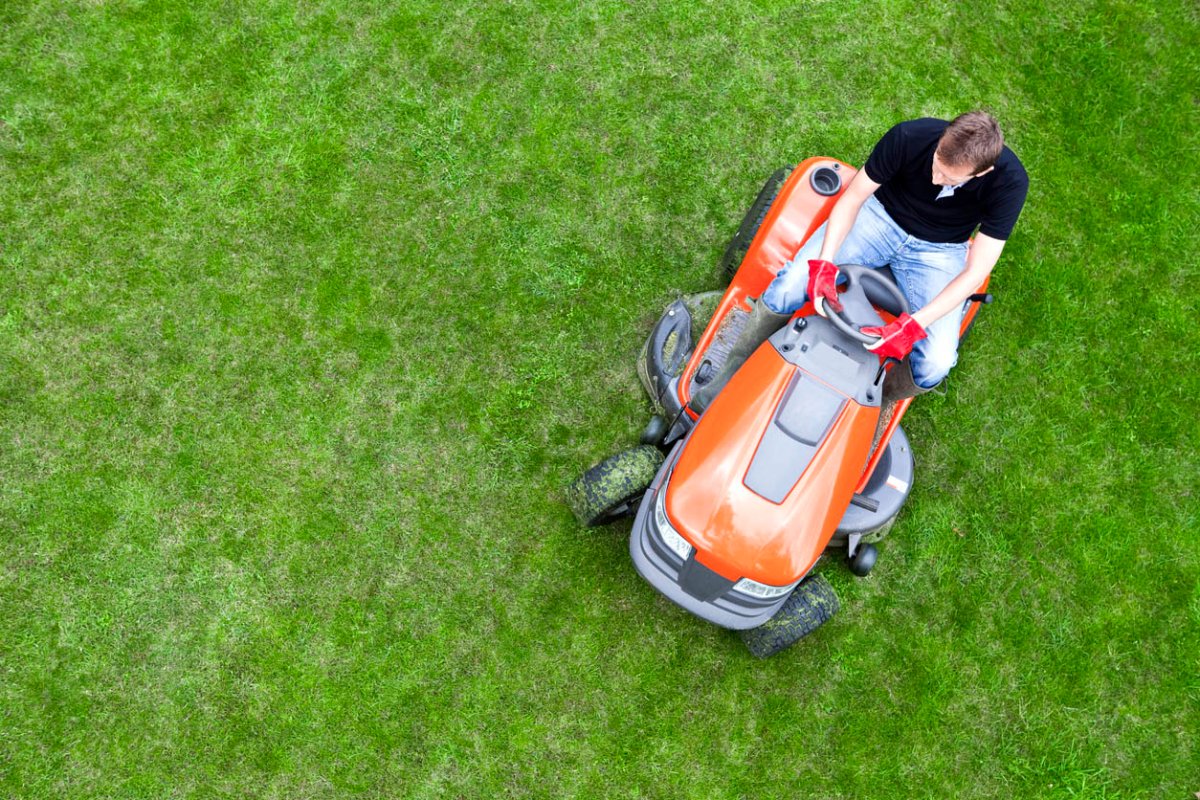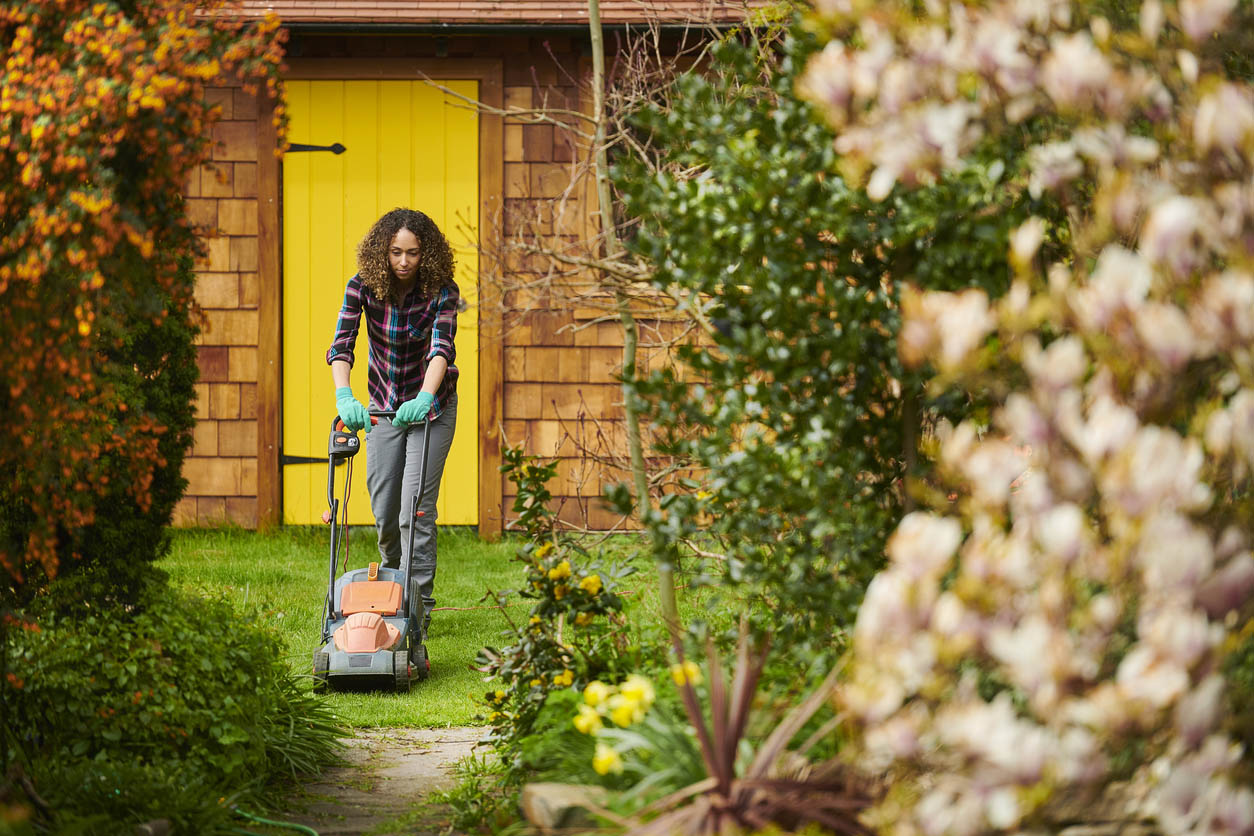

We may earn revenue from the products available on this page and participate in affiliate programs. Learn More ›
Compliment a neighbor’s lovely green lawn, and they’ll beam with pride, but what they might not tell you is how much work is involved. For many gardeners, it’s not the tasks themselves that are difficult; it’s knowing the right time to perform them. Enter the ultimate month-by-month lawn care calendar designed to help anyone figure out their own lawn maintenance schedule.
Any lawn care plan will vary based on the region, type of grass, and weather conditions—among other factors. For example, some places in the northern climate zones have much longer winters, and some of the spring lawn care tips may not be applicable in March or even April but can be applied in May. By contrast, in transition zones lawns may already need mowing and irrigation before April ends. Think of this handy month-by-month lawn care calendar as a baseline that can be tailored to the lawn maintenance schedule best for the turf in your own yard.

Month-by-Month Lawn Care Calendar
Use this calendar for lawn maintenance as a quick guide to see what tasks to complete when. There will be variations depending on the climate and the weather patterns in any given season. Think of it as the DIY version of the lawn care scheduling software the pros use. Then, keep reading for more details on what goes into each month.
| January | Mower maintenance, supply purchasing |
| February | Mower maintenance, supply purchasing, irrigation system check |
| March | Yard cleanup, soil testing, aeration, dethatching, irrigation system check |
| April | Yard cleanup, aeration, dethatching, fertilizing, grub control (cool season grasses) |
| May | Aeration, fertilizing, grub control (cool season grasses) |
| June | Weeding, mowing, fertilizing, irrigation, grub control (warm and cool season grasses) |
| July | Weeding, mowing, fertilizing, irrigation, grub control (warm and cool season grasses) |
| August | Weeding, mowing, irrigation |
| September | Weeding, mowing, irrigation, aeration, fertilizing, reseeding |
| October | Aeration, fertilizing, cleanup, mulching |
| November | Yard cleanup, irrigation system winterization, mower maintenance |
| December | Mower maintenance, supply purchasing |
Remember: Your Lawn Care Calendar Will Vary Depending on Your Grass Type
Although at a glance all lawns may look the same, there are actually many varieties of turfgrass that are suited to different climates. And one of the best things to do for any lawn is to plant the right kind of grass for your specific growing zone.
Most turfgrass is classified into two main types: cool-season grasses and warm-season grasses. The “transition zone” is an area that falls between the northern and southern climates and can grow either type of grass.
Cool-Season Grasses vs. Warm-Season Grasses vs. Transition Zone
Cool-season grasses grow in areas that get cold winters and hot summers, such as Northern California, the Upper Midwest, the Pacific Northwest, and the Northeast.
Grasses include:
- Kentucky bluegrass
- Ryegrasses
- Fescues
Some characteristics of cool-season grasses:
- Best suited to areas with cold winters and hot summers
- Best grown in climates where spring and early-fall temperatures range from 60 to 75 degrees Fahrenheit
- Will likely stay green until temperatures go below 32 degrees Fahrenheit
- Can withstand periods of freezing temperatures in winter
- Active growth occurs in spring and early fall
Warm-season grasses do best in the southern climates of the Southeast and Southwest.
Grasses include:
- Zoysia
- Bermuda grass
- Bahia grass
- Centipede grass
- St. Augustine grass
- Kikuyu grass
Some characteristics of warm-season grasses:
- Best suited to thrive in temperatures between 75 and 95 degrees Fahrenheit
- Will likely turn brown and go dormant when temperatures drop below 50 degrees Fahrenheit
- Most warm-season grass species cannot survive extended periods below freezing (32 degrees Fahrenheit)
- Active growth occurs in midsummer
Transition-zone grasses can be grasses from either category.
- Warm-season grasses like zoysia and Bermuda grass are winter-hardy enough for the transition zone.
- For a cool-season species that can tolerate warmer winters, look for tall fescue.

Spring Lawn Care
Months: March, April, May
Key Tasks: Cleanup, soil testing, aeration, dethatching, fertilizing, overseeding, pre-emergent application, mower maintenance, grub control (cool-season grasses), irrigation system check
Spring can be the busiest time for lawn care, but the hard work now will pay off in the form of a lush lawn to enjoy in the summer months. Much of the work done in the spring is prep work to ensure grass gets the nutrients it needs to grow thick and green. The beginning of the spring will include tasks like cleaning up, soil testing, dethatching, and aerating. Mid-spring is the time to overseed and apply one of the best lawn fertilizers. In some climates, mowing may be necessary before or during May depending on the weather and the rate of growth that season.
- Rake: Lightly rake up yard debris such as leaves, dead grass, and small branches.
- Test soil: Use a soil-test kit to determine if any nutrient deficiencies should be addressed with spring fertilizing. Use one of the best at-home soil test kits for fast results, and decide if it’s necessary to lower the soil pH or increase it.
- Dethatch: A thin layer of thatch helps grass maintain moisture and provides protection from temperature extremes, but too much thatch can prevent nutrients and water from reaching the turf roots. If thatch appears thicker than ½ inch, use a dethatching rake to lift and break up some of it throughout the lawn.
- Aerate: Aerating is the process of putting holes in the soil in order to avoid soil compaction. Spring is an excellent time to aerate the lawn and help all of the air, water, and fertilizer get to the soil and roots of the turf. Aeration should happen at least once a year, but in areas with heavy traffic, aerating is recommended in both spring and fall. Use a handheld core aeration tool or rent an aerator.
- Overseed: Although the fall is typically the best time to reseed a lawn, early to mid-spring is a great time to overseed any thin patches. Use a grass seed mix appropriate for the climate zone and a seed spreader for even distribution, or simply sprinkle by hand and keep the seeds moist while they’re germinating.
- Fertilize: The best time to fertilize grass is just as it starts the period of active growth. For areas with cool-season grasses, the early spring (April) is the ideal time to fertilize. For areas with warm-season grasses, later spring (May) is best. Use either a liquid or a granular, slow-release fertilizer formulated for turf. Quick-acting fertilizers tend to harm grass.
- Mower maintenance: It’s a good idea to avoid mowing until the end of spring, so in the meantime, getting those mower blades sharpened and making sure the mower is in good working order can be a good way to prepare.
- Irrigation system check: If there is an existing sprinkler system in place, make sure it’s in good working order and use this time to replace broken heads or repair lines. Turn on outside spigots and flush hoses and sprinklers in preparation for warmer weather.
- Pre-emergent application: If there is a concern about crabgrass or major weed infestations, early spring is the time to apply pre-emergent herbicides. Keep in mind, however, that pre-emergents can prevent new seeds from sprouting, so skip this step if you’re overseeding the grass.
- Grub control: If there is a concern about grub damage, treatment should take place when grubs are hatching. This is roughly late spring through mid-June, depending on the zone.

Summer Lawn Care
Months: June, July, August
Key Tasks: Weeding, mowing, fertilizing*, irrigation, grub control
The long-awaited days of summer mean warmth and, therefore, active growth for both cool-season and warm-season grasses. While much of the lawn care prep has been taken care of in the spring, the summer months focus on the maintenance of the grass. Apart from applying an insecticide for grub control, which should take place in the early part of the summer, the other tasks are ongoing throughout the season.
- Weeding: Remove weeds by hand before they get too big. If weeds are a larger problem, use a post-emergent herbicide to spot-treat weeds. It’s advised to use the treatment sparingly and to avoid spraying on a windy day or during the heat of the day. Broadly spraying herbicides on grass will likely damage and possibly kill turf.
- Mowing: Avoid mowing until the grass is at least 3 inches in height, then mow just one-third of the grass’s height. The frequency of mowing will depend on the weather: Periods with warmer temperatures and plenty of rain will result in faster growth, and mowing may be required weekly. Long periods of dry, warm weather can slow growth.
- Fertilizing*: Not all gardeners fertilize throughout the summer months, but some choose to use regular fertilizer on their lawns during the summer. This is most often a water-soluble fertilizer that is applied directly to the lawn via a hose-end sprayer. This type of fertilizer should be applied in the early morning before temperatures rise and never in the middle of the day.
- Irrigation: While some climates require lawn watering as early as late April or May, especially if conditions are dry and windy, by the summer, a regular irrigation pattern should be established. How frequently grass is watered will depend on how much (or how little) rainfall there is and other conditions like heat and wind. Generally, turfgrass only needs about 1 inch of water per week.
- Grub control: If there is a concern about grub damage, for cold-season grasses, treatment can take place into June. For warm-season grasses, June and July are the best months.

Fall Lawn Care
Months: September, October, November
Key Tasks: Weeding, mowing, irrigation, fertilizing, aeration, pre-emergents, post-emergents, overseeding, reseeding
As summer fades, the fall lawn care schedule becomes a combination of maintenance like irrigation and mowing, as well as preparing turf and the soil that supports it so they’re ready for cooler months. During September and, for some, even into October, the grass will likely require regular watering and mowing, though these will become less frequent as the season progresses. Fall is a great time to consider fertilizing and aeration, along with some weed control. Much of the prep work is best done in October before frost (if there will be one) sets in. By November, many of the tasks are done.
- Weeding: Continue to hand-dig weeds as needed. Apply any pre- or post-emergents if desired, such as a pre-emergent for crabgrass.
- Mowing: The rate of growth will slow down dramatically, though mowing may be necessary throughout September and possibly even early October. Leave grass clippings on the lawn for nutrients and cold-weather protection.
- Aeration: After a summer of foot traffic, aeration is a good idea to ensure nutrients and autumn rains reach the roots of the grass.
- Fertilizing: Choose a slow-release, well-balanced lawn fertilizer, such as a granular fertilizer, that will break down slowly over the winter months, enriching the soil for optimal growth the following spring.
- Irrigation: September can be a warm month in some areas, so if the weather requires it, it’s best to keep up with a regular irrigation routine.
- Reseeding: Seed grass at least 2 months before the first frost sets in. For many climates, this is September but can be into early October.
- Yard cleanup: Continue picking up small debris and maintaining lawn edges. Rake up leaves and other debris early in the season, but as autumn progresses, some leaves on the lawn can be beneficial. In October, use the lawn mower to mow over the scattered leaves and create a natural (and free) mulch.
Winter Lawn Care
Months: December, January, February
Key Tasks: Winterizing tools and irrigation systems, mower maintenance, supply purchasing
Whether the grass goes dormant or is covered in snow, winter requires the least amount of seasonal lawn care, but that doesn’t mean it’s out of mind completely. Winter is a good time to take stock of what supplies were depleted and what needs replacing, in addition to troubleshooting any problems and improving upon the year’s lawn care plan.
- Yard cleanup: Continue picking up debris from the lawn as needed. Clean up and store garden tools as well as hoses. Shut off irrigation, and close outside spigots.
- Mower maintenance: Perform routine maintenance on lawn mowers, such as oil changes, filter cleanup, and blade sharpening.
- Supply purchases: Make a list of supplies needed for the growing season including grass seed and fertilizer, and order in advance so they are on hand when the weather changes.
Following a month-by-month lawn care calendar is an easy way for gardeners to keep their lawn maintenance schedule manageable. Knowing the window of time to take care of key tasks ensures that there’s enough time set aside to do the work, and enough time set aside to enjoy the fruits—or the thick green lawn—of your labors. But if all else fails, head to the pool and let one of the best lawn care services handle it all for you. Need a do-it-yourself lawn care schedule? One of the best DIY lawn care programs like Sunday can help streamline your lawn’s maintenance so it’s as easy as opening a box delivered right to your door.
- Want to know more? Read our Sunday Lawn Care review
Pro Tips
Creating a do-it-yourself lawn care schedule will require a certain amount of trial and error. Here are a few tips and tricks to avoid common mistakes.
- Many lawns benefit from dethatching in spring before applying fertilizer, but dethatching too early in the spring can damage the grassroots and tender crowns. It’s a good idea to wait a week or more after snowmelt and major water saturation before undertaking any major dethatching task.
- Avoid mowing too early in the season: Be sure the grass is at least 3 inches tall before the first mow, and only cut one-third of the height. Mowing too short can lead to dried-out grass and invite diseases and pests.
- Fact-acting, high-nitrogen fertilizers can stimulate growth but can cause damage to lawns by burning tender new growth. Opt for a slow-release fertilizer to build soil health over time.
- Some gardeners choose to feed lawns continuously throughout the growing season, especially with a water-soluble fertilizer. A well-balanced, slow-release fertilizer in the spring and fall is also sufficient. Choose the option that is easiest for you, and make sure you follow a lawn fertilizer schedule so you don’t overfertilize, which can lead to an unhealthy and stressed lawn.
- Weeds are not the enemy; having a few weeds in a lawn is normal. In fact, some pro-pollinator organizations like Bee City USA encourage a “No Mow May” to allow “weeds” like dandelions and clover to bloom and provide food for pollinators.
- Insecticides can be harmful to pollinators like bees, as well as pose risks to pets and children. Grub control is usually the most common treatment and is most effective when grubs are just hatching. For cool-season grasses, this can take place anytime between April and July. For warm-season grasses, treatment is best applied in June and July.
- Overseeding small patches is easier than you think and requires little more than grass seed. Spreading by hand is fine, and the secret to success is to keep the seeds moist without flooding them and washing them away.
- Bare spots on the lawn can have many causes: underwatering, overwatering, overfertilizing, pet urine, insects, and diseases. Before attempting to treat bare or thinning spots, try to identify the exact cause of the problem.
